Optimization Strategy and Evaluation of the Flow Heat Characteristics of the Cooling Plates of Electromagnetic Separators
Abstract
1. Introduction
2. Establishment of Mathematical Model
2.1. Modeling of Electromagnetic Separator and Cooling Plate
2.2. Establishment of the Fluid–Thermal Coupling Model
2.3. Model Assumptions and Setting of Boundary Conditions
- Each part of the windings generates heat uniformly, and other heat sources are ignored;
- Fluid motion is complex with a large Reynolds number, so the k-Omega turbulence model is used to calculate the flow field of the motor;
- The fluid is incompressible;
- To ensure the accuracy of the solution, polyhedral meshes are set, with their orthogonality quality guaranteed to be above 0.2; the mesh meshing diagram is shown in Figure 3.
- Boundary conditions are set for the model as follows:
- The ambient temperature is set to 25 °C, and all surfaces in contact with air are configured for convective heat transfer;
- The coolant temperature is 25 °C; the specific physical parameters of the coolant and other main materials are shown in Table 2.
- The fluid inlet is set as a velocity inlet; the fluid outlet is set as a pressure outlet.
3. CFD-Based Research on Heat Transfer of Heat Sink
3.1. The Influence of the Number of Water Channels on the Heat Transfer of the Cooling Plate
3.2. The Influence of the Channel Cross-Section Area on the Heat Transfer of the Cooling Plate
4. Optimization Strategy of the Cooling Plate
4.1. An Innovative Semicircular Groove Structure
4.2. Optimization Strategy Based on RSM and Genetic Algorithm
- An increase in groove radius and a decrease in groove spacing both increase the roughness of the inner wall of the cooling plate, enhance the flow resistance of the fluid, and ultimately reduce the average flow velocity of the coolant in the cooling plate. Nu varies between 4.163 and 4.403, with a small overall trend, ranging from a minimum when l is 45 mm and r is 1 mm to a maximum when l is 10 mm and r is 5 mm;
- An increase in groove radius and a decrease in groove spacing strengthen the turbulence effect, thereby improving the heat transfer capacity of the wall. However, since their impact on flow velocity is negative, under the mutual restriction of these two conditions, Nu shows a trend of first increasing and then decreasing with the increase in groove radius and the decrease in groove spacing. The mean flow velocity varies from 0.607 m/s to 0.7295 m/s, with a minimum when l is taken as 5 mm and r is taken as 1 mm, and a maximum when l is taken as 10 mm and r is taken as 5 mm;
- An increase in groove radius and a decrease in groove spacing can effectively enhance the heat transfer capacity of the cooling plate, and both can reduce the maximum temperature of the magnetic separator. The maximum temperature varies from 67.9 to 67.9, and the overall trend is not significant, with a minimum when l is 45 mm and r is 1 mm, and a maximum when l is 10 mm and r is 5 mm;
- An increase in groove radius and a decrease in groove spacing lead to an increase in pressure drop. This is because an increase in groove radius changes the flow channel shape and roughness, while more dense grooves further increase flow resistance; the increased fluid flow resistance ultimately results in a rise in pressure drop. The pressure drop varies from 4.163 kPa to 33.96 kPa, with the overall trend being small, taking a minimum when l is taken as 5 mm and r is taken as 1 mm and a maximum when l is taken as 10 mm and r is taken as 5 mm.
4.3. Finite Element Analysis of Optimization Results
- Through a comparative analysis of the predicted values and finite element calculation results, the findings show that the error rates of all key indicators (e.g., flow velocity, pressure drop, temperature) are controlled within 2%. These errors arise from the interaction of the algorithm’s inherent approximation, computing resource limitations, and model errors; however, the error magnitudes are relatively small and acceptable in engineering practice. These data fully demonstrate that the mathematical model, boundary condition settings, and algorithm employed in the structural parameter optimization of the cooling plate exhibit high accuracy and reliability.
- Compared with the cooling plate with smooth walls, the introduction of the groove structure significantly changes the geometric shape of the flow channel. This causes a significant increase in internal pressure when the fluid flows through the groove area due to increased local resistance (such as eddy current loss and boundary layer separation). Additionally, the protrusions or depressions of the grooves have a retarding effect on fluid flow. Although the local flow velocity in narrow or deep grooves may increase, the overall average flow velocity is lower than that of the smooth-walled cooling plate.
- By comparing the experimental data, it can be seen that after introducing the groove structure, the thermal management performance of the electromagnetic coil is significantly optimized. The maximum temperature of the coil decreases from 82.45 °C (with smooth walls) to 69.82 °C, a reduction of 12.63 °C, with a decrease rate as high as 15.31%. This indicates that the groove structure effectively enhances the convective heat transfer process by increasing wall roughness and promoting fluid disturbance (such as increased turbulence intensity or generation of secondary flow), thereby accelerating the heat transfer from the coil to the cooling medium.
5. Experiment Validation
6. Conclusions
- The increase in the number of cooling channels significantly improves the coolant flow rate and Nu of the cooling plate, thereby enhancing its heat dissipation capability and reducing the coil temperature of the electromagnetic separator. However, it also leads to an increase in pressure drop, which raises the required pump power for the cooling plate. Therefore, when determining the number of water channels for the S-shaped water channel, it is necessary to balance economic efficiency.
- With the number of channels fixed, reducing the height dimension can increase the coolant flow velocity and Nu, further enhancing the heat transfer capacity of the cooling plate. Nevertheless, a decrease in hydraulic diameter causes a sharp increase in flow channel resistance, resulting in multiple increases in the inlet–outlet pressure drop.
- This paper proposed a semi-circular groove structure, and the structural parameters of the grooves were optimized based on RSM and the genetic algorithm. The results show that the introduction of grooves enhances the turbulence effect, further improving the heat transfer capacity of the cooling plate. After optimization, the maximum temperature decreased by 12.63 °C with a reduction rate of 15.31%, and the error between the predicted values and finite element simulation results was less than 2%, verifying the accuracy of the optimization method. Despite the presence of a small boost in pressure drop, a smaller mention is acceptable.
- A cooling plate was fabricated with optimized parameters, and an experimental platform for the electromagnetic separator and its cooling system was built. The experimental results are consistent with the simulation results, indicating that optimization can effectively enhance the heat dissipation capacity of the cooling plate, verify the accuracy and feasibility of the simulation, and provide a reference for subsequent structural design of cooling plates.
Author Contributions
Funding
Data Availability Statement
Conflicts of Interest
Abbreviations
| PMCP | Parallel microchannel cooling plates. |
| DSC-CP | A double serpentine channel cooling plate. |
| TMS | Thermal management systems. |
| GV-CNF | Gradually varied circular notched fins. |
| RSM | Response Surface Methodology. |
| CFD | Computational Fluid Dynamics. |
| Re | Reynolds number. |
| Nu | Nusselt number. |
| Pr | Prandtl number. |
References
- Ma, N.; Houser, J.B. Recycling of steelmaking slag fines by weak magnetic separation coupled with selective particle size screening. J. Clean. Prod. 2014, 82, 221–231. [Google Scholar] [CrossRef]
- Cao, Q.; Han, X.; Lai, Z.; Xiong, Q.; Zhang, X.; Chen, Q.; Xiao, H.; Li, L. Analysis and reduction of coil temperature rise in electromagnetic forming. J. Mater. Process. Technol. 2015, 225, 185–194. [Google Scholar] [CrossRef]
- Wang, Q.; Dai, Y.; Huang, H.; Song, S.; Zhang, B.; Kim, K.; Oh, S. Development of conduction-cooled high temperature superconducting magnet. IEEE Trans. Appl. Supercond. 2005, 15, 2332–2335. [Google Scholar] [CrossRef]
- Rey, C.; Hoffman, W.; Cantrell, K.; Eyssa, Y.; VanSciver, S.; Richards, D.; Boehm, J. Design and fabrication of an HTS reciprocating magnetic separator. IEEE Trans. Appl. Supercond. 2002, 12, 971–974. [Google Scholar] [CrossRef]
- Chen, K.; Chen, Y.; Song, M.; Wang, S. Multi-parameter structure design of parallel mini-channel cold plate for battery thermal management. Int. J. Energy Res. 2020, 44, 4321–4334. [Google Scholar] [CrossRef]
- Hamrang, A.; Abdollahzadeh, M.; Kermani, M.; Rahgoshay, S. Numerical simulation of the PEM fuel cell performance enhancement by various blockage arrangement of the cathode serpentine gas flow channel outlets/inlets. Int. J. Heat Mass Transf. 2022, 186, 122475. [Google Scholar] [CrossRef]
- Raza, W.; Islam, N.; Samad, A. Design and analysis of a novel Bi-layer curved serpentine chaotic micromixer for efficient mixing. Chem. Eng. Process.-Process Intensif. 2023, 183, 109246. [Google Scholar] [CrossRef]
- Masaeli, N.; Afshari, E.; Baniasadi, E.; Baharlou-Houreh, N. Performance studies of a membrane-based water and heat exchanger using serpentine flow channels for polymer electrolyte membrane fuel cell application. Appl. Therm. Eng. 2023, 222, 119950. [Google Scholar] [CrossRef]
- Siddiqui, M.; Shahab, M.; Siddiqui, O.; Ali, H.; Zubair, S.M. A comprehensive multi-physics model of photovoltaic modules with non-uniform solar concentration and serpentine cooling. Energy Convers. Manag. 2022, 271, 116266. [Google Scholar] [CrossRef]
- Imran, A.A.; Mahmoud, N.S.; Jaffal, H.M. Analysis of channel configuration effects on heat transfer enhancement in streamline-shaped cold plates used in battery cooling system: A comparative study. Int. Commun. Heat Mass Transf. 2024, 155, 107570. [Google Scholar] [CrossRef]
- Yogeshwar, D.; Repaka, R.; Marath, N.K. A double serpentine channel liquid cooling plate for hotspot targeted cooling of lithium-ion batteries in a battery module. Int. J. Therm. Sci. 2025, 209, 109521. [Google Scholar] [CrossRef]
- Zhang, H.; Liu, Y.; Guo, J. A Study on the Heat Dissipation Effects During the Meshing Process of Involute Gears with Variable Tooth Thickness. Machines 2025, 13, 686. [Google Scholar] [CrossRef]
- Mubashir, M.; Xu, J.; Guo, Z.; Wang, X.; Wang, H.; Qiao, F.; Li, E.; Mei, X. Numerical investigation of a novel cold plate design with uniform circular hollow fins for battery thermal management systems. Appl. Therm. Eng. 2024, 237, 121791. [Google Scholar] [CrossRef]
- Zhang, L.; Ma, Y.; Lv, M.; Wang, X.; Shi, X. Performance-Enhanced Double Serpentine Minichannel Heat Sink for Phased-Array Radar High-Heat-Flux Chip Cooling. Electronics 2025, 14, 2246. [Google Scholar] [CrossRef]
- Gao, H.; Hou, X.; Ma, W.; Ma, Y. Design and Thermal Performance Analysis of a Liquid Cooling Plate Based on Gradually Varied Circular Notched Fins for Lithium-Ion Batteries. Processes 2025, 13, 924. [Google Scholar] [CrossRef]
- Li, Q.-X.; Pan, M.; Dong, Y.-H. Turbulence modulation and heat transfer enhancement in channels roughened by cube-covered surface. Comput. Fluids 2018, 165, 33–42. [Google Scholar] [CrossRef]
- Liu, H.; Gao, X.; Zhao, J.; Yu, M.; Niu, D.; Ji, Y. Liquid-based battery thermal management system performance improvement with intersected serpentine channels. Renew. Energy 2022, 199, 640–652. [Google Scholar] [CrossRef]
- Fan, L.; Li, J.; Chen, Y.; Zhou, D.; Jiang, Z.; Sun, J. Study on the cooling performance of a new secondary flow serpentine liquid cooling plate used for lithium battery thermal management. Int. J. Heat Mass Transf. 2024, 218, 124711. [Google Scholar] [CrossRef]
- Ansari, M.Q.; Zhou, G. Flow and heat transfer analysis of microchannels structured with rectangular surface roughness. Chem. Eng. Process.-Process Intensif. 2020, 156, 108066. [Google Scholar] [CrossRef]
- Gorzin, M.; Ranjbar, A.A.; Hosseini, M.J. Experimental study on serpentine minichannel heat sink: Effect of rib existence and distance. Int. J. Therm. Sci. 2022, 173, 107397. [Google Scholar] [CrossRef]
- Yang, M.; Zhang, S.; Tian, H.; Lv, L.; Han, J. Research on Thermal Characteristics and Algorithm Prediction Analysis of Liquid Cooling System for Leaf Vein Structure Power Battery. Batteries 2025, 11, 326. [Google Scholar] [CrossRef]
- Guo, Z.; Rao, Y.; Li, Y.; Wang, W. Experimental and numerical investigation of turbulent flow heat transfer in a serpentine channel with multiple short ribbed passes and turning vanes. Int. J. Therm. Sci. 2021, 165, 106931. [Google Scholar] [CrossRef]
- Yu, C.; Li, H.; Chen, J.; Qiu, S.; Yao, F.; Liu, X. Investigation of the thermal performance enhancement of a photovoltaic thermal (PV/T) collector with periodically grooved channels. J. Energy Storage 2021, 40, 102792. [Google Scholar] [CrossRef]
- Kani, T.G.; Ghahremani, A. Optimal design of heat pipes for city gate station heaters by applying genetic and Bayesian optimization algorithms to an artificial neural network model. Case Stud. Therm. Eng. 2024, 55, 104203. [Google Scholar] [CrossRef]
- Li, Z.; Zhu, W.; Wang, B.; Wang, Q.; Du, J.; Sun, B. Optimization of cooling water jacket structure of high-speed electric spindle based on response surface method. Case Stud. Therm. Eng. 2023, 48, 103158. [Google Scholar] [CrossRef]
- Gao, G.; Xu, F.; Xu, J. Parametric optimization of FDM process for improving mechanical strengths using Taguchi method and response surface method: A comparative investigation. Machines 2022, 10, 750. [Google Scholar] [CrossRef]
- Guo, R.; Li, L. Heat dissipation analysis and optimization of lithium-ion batteries with a novel parallel-spiral serpentine channel liquid cooling plate. Int. J. Heat Mass Transf. 2022, 189, 122706. [Google Scholar] [CrossRef]
- Xu, X.; Tong, G.; Li, R. Numerical study and optimizing on cold plate splitter for lithium battery thermal management system. Appl. Therm. Eng. 2020, 167, 114787. [Google Scholar] [CrossRef]
- Liu, J.; Ai, M. Structural optimization design and heat transfer characteristics of air-to-air cooled high voltage motor heat exchanger. Case Stud. Therm. Eng. 2022, 40, 102532. [Google Scholar] [CrossRef]


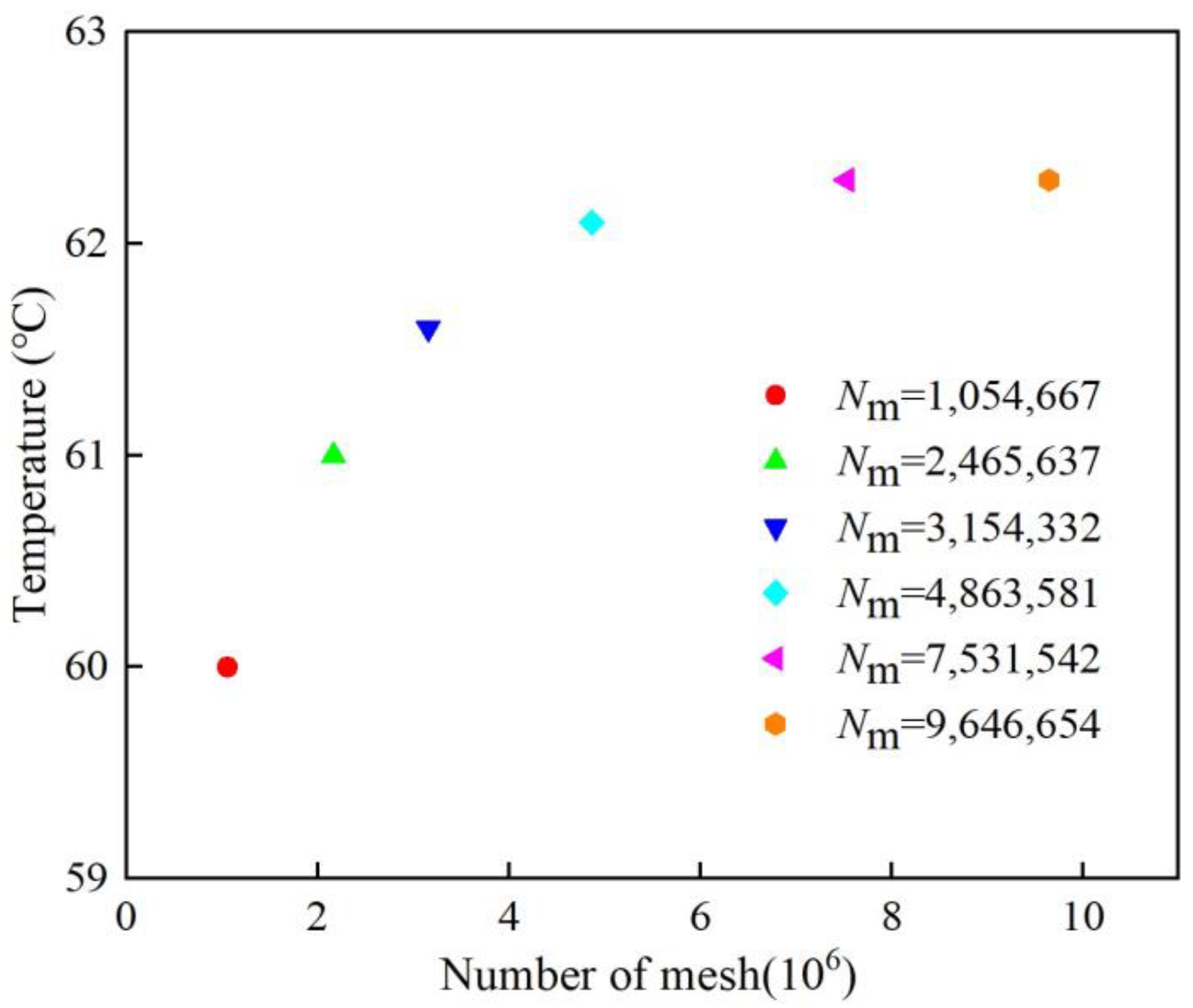

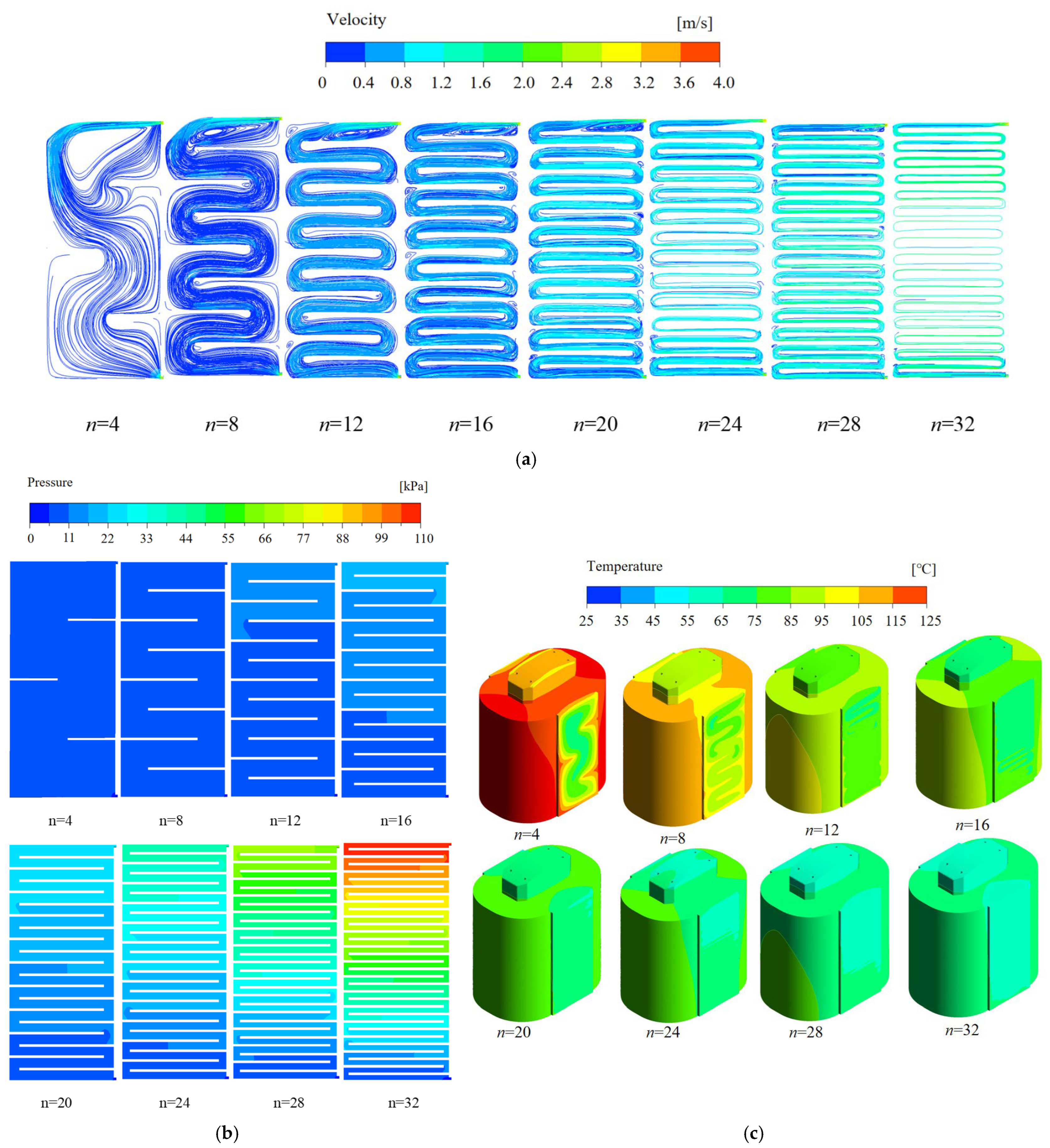
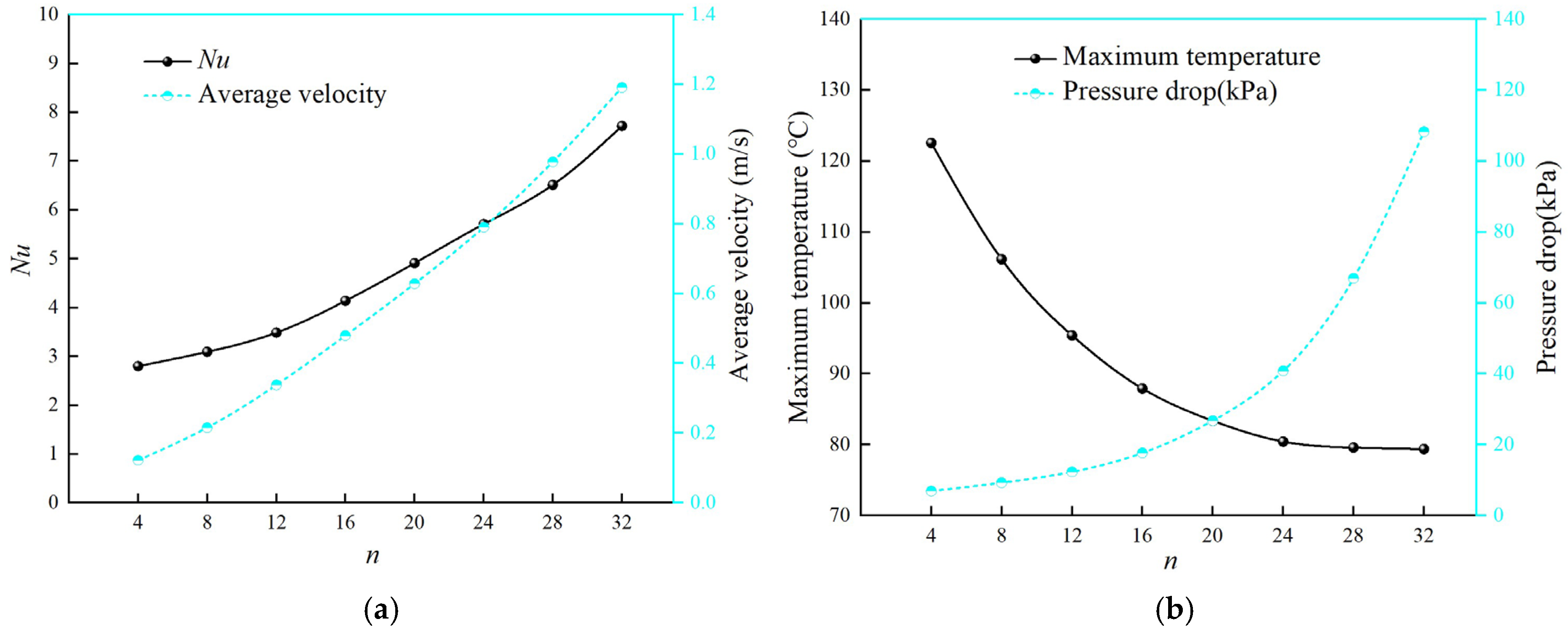
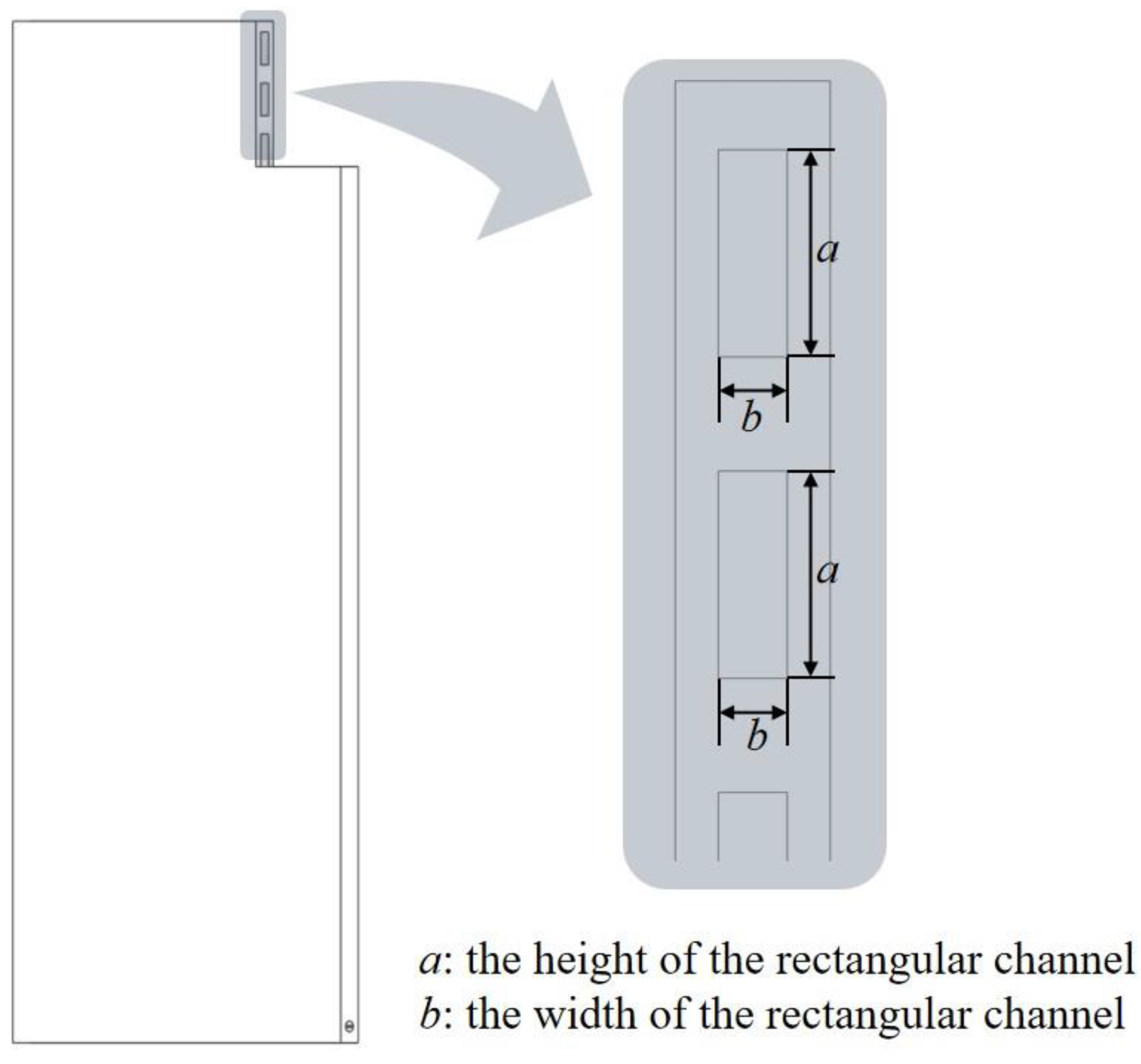
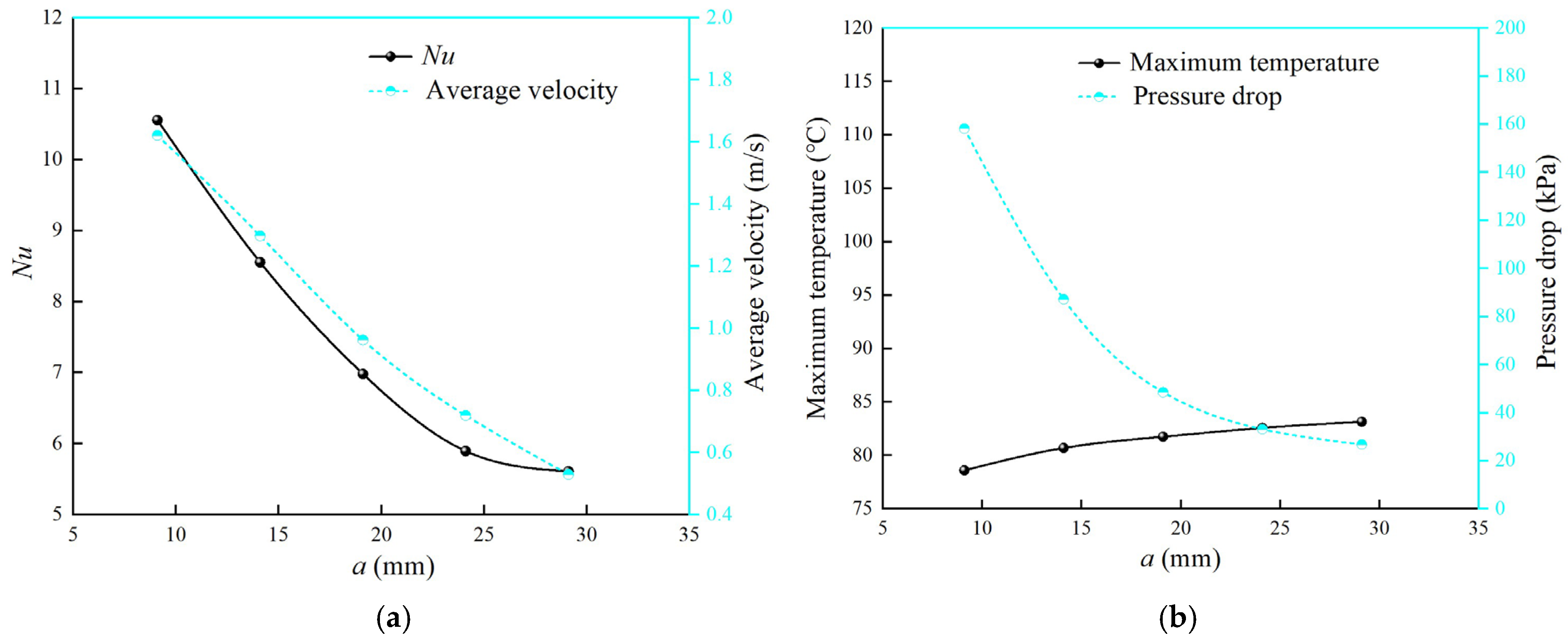
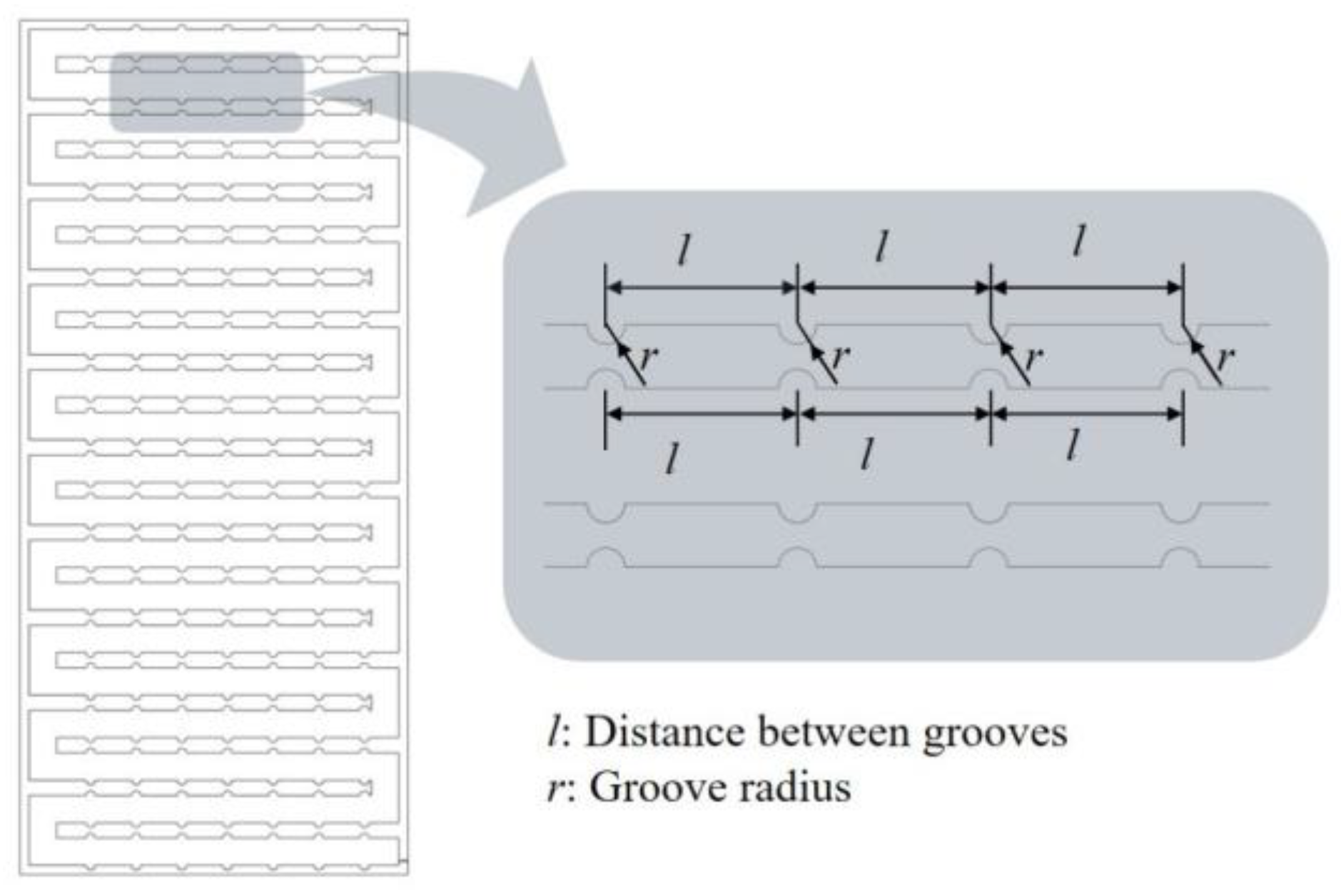

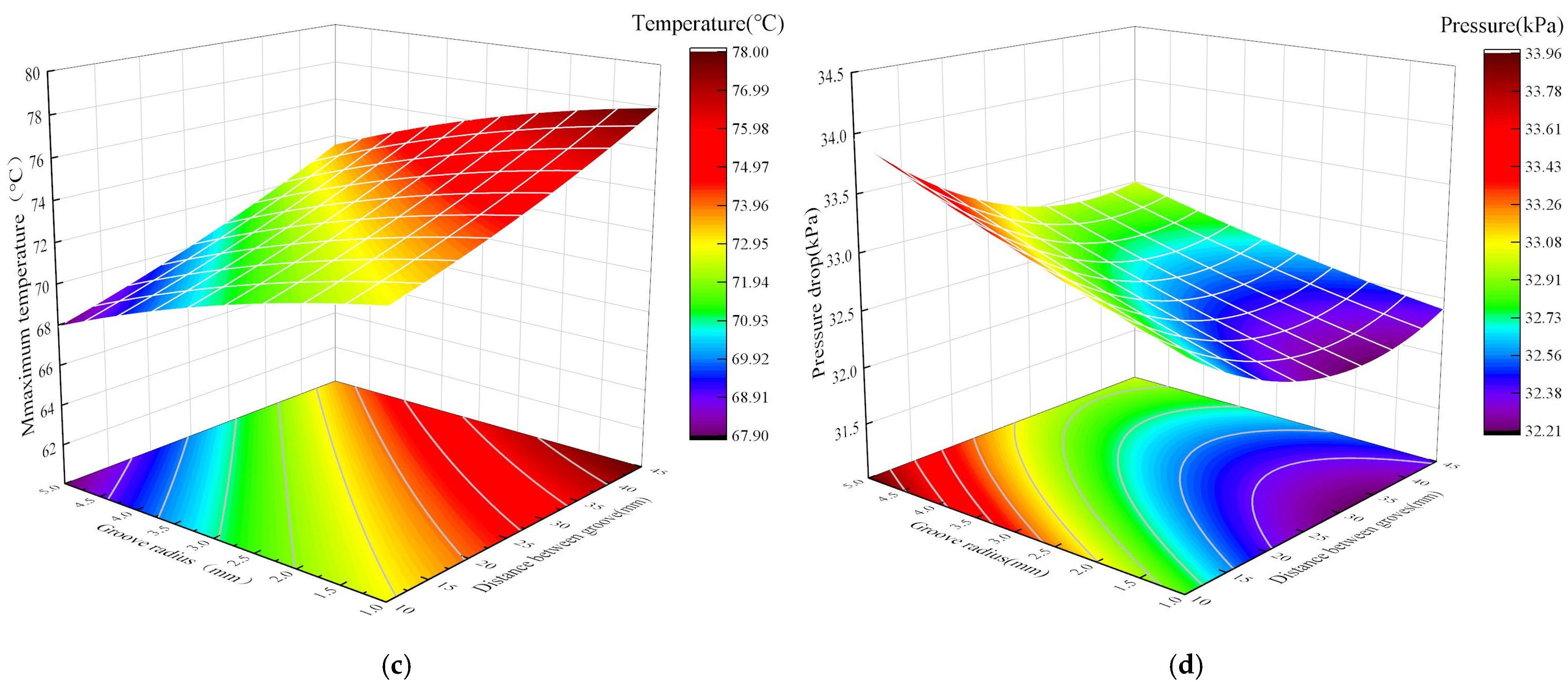



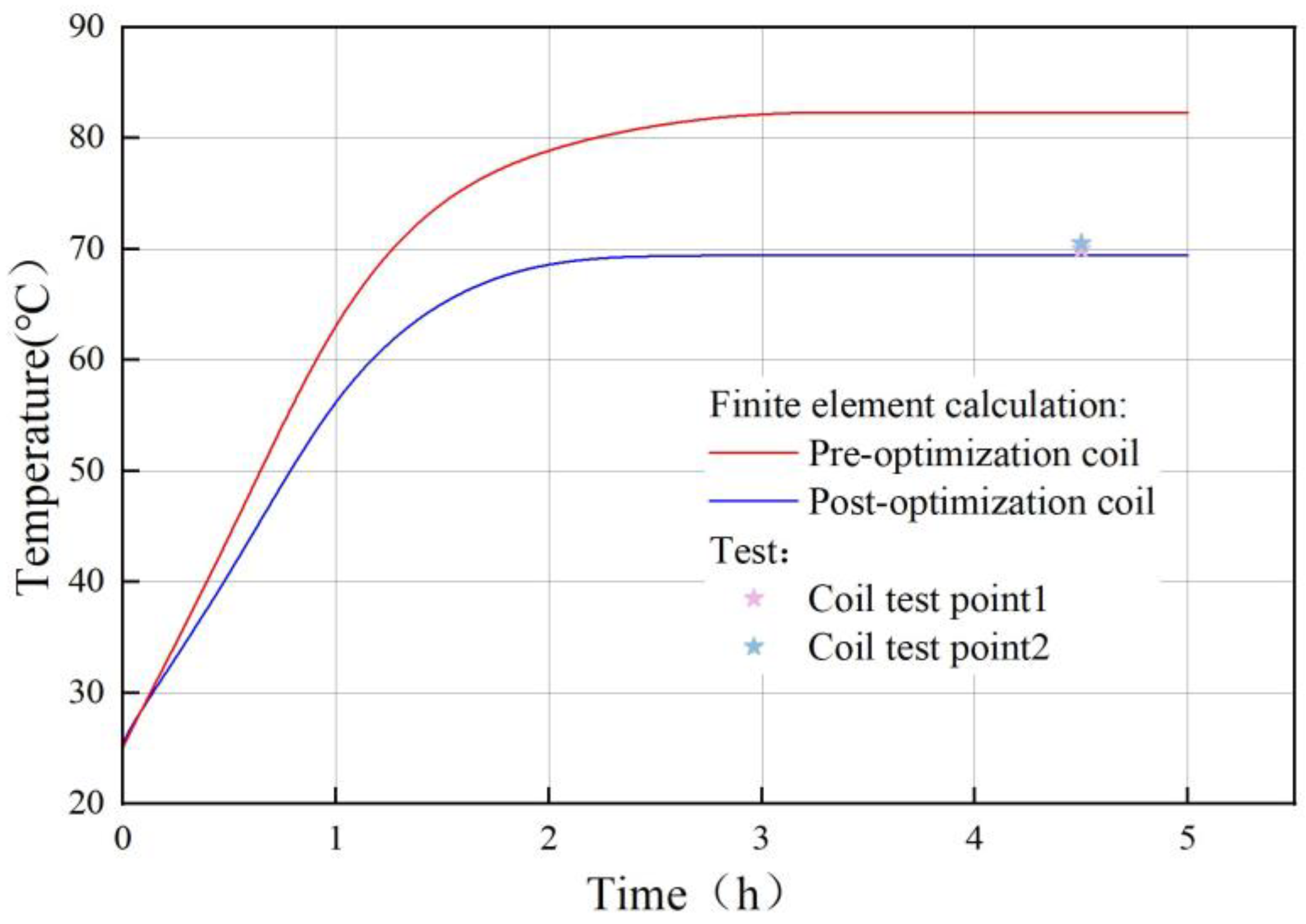
| Parametric | Electromagnetic Separator | Unit |
|---|---|---|
| Separator Diameter | 1500 | mm |
| Axial length | 1500 | mm |
| Power | 12 | kW |
| Input voltage | 115 | V |
| Excitation source | Coils/Flat Aluminum Wires | |
| Insulation class | E class (120 °C) | |
| Cooling plate sizes | 750 × 340 × 18 | mm |
| Parts | Heat Conductivity (W/m·K) | Density (kg/m3) | Specific Heat Capacity (J/kg·K) |
|---|---|---|---|
| Core | 45 | 7850 | 500 |
| Coil | 383 | 8900 | 700 |
| Cooling plate | 204 | 2700 | 2090 |
| Coolant (Transformer oil) | 0.13 | 895 | 1975 |
| Parameters | R2 |
|---|---|
| Nu(n) | 0.994 |
| vavg(n) | 0.987 |
| Tmax(n) | 0.999 |
| ΔP(n) | 0.983 |
| Parameters | R2 |
|---|---|
| Nu(a) | 0.992 |
| vavg(a) | 0.997 |
| Tmax(a) | 0.995 |
| ΔP(a) | 0.994 |
| Nu | vavg (m/s) | ΔP (kPa) | Tmax (°C) | |
|---|---|---|---|---|
| Pre-optimization (calculated value) | 4.24 | 0.762 | 32.89 | 82.45 |
| Post-optimization (calculated value) | 4.34 | 0.65 | 32.97 | 69.82 |
| Optimized (predicted) | 4.38 | 0.637 | 33.16 | 68.74 |
| Percentage error in forecasting | 0.92% | 2% | 0.58% | 1.55% |
| Experimental Component | Equipment Specifications | Value | Unit | |
|---|---|---|---|---|
| Prototype |
| Sizes | 750 × 550 × 800 | mm |
| Sizes | 1500 × 1500 | mm | |
| Sizes | 900 × 460 × 200 | mm | |
| Sizes | 750 × 340 × 18 | mm | |
| Electricity supply |
| Input voltage | 115 | V |
| Temperature measuring device |
| 561 HVAC | −40~550 (accuracy 0.1) | °C |
| A Class | 40~71 (accuracy 1) | °C | |
| Cooling supply |
| Fluke 561 | 2.25 | kW |
Disclaimer/Publisher’s Note: The statements, opinions and data contained in all publications are solely those of the individual author(s) and contributor(s) and not of MDPI and/or the editor(s). MDPI and/or the editor(s) disclaim responsibility for any injury to people or property resulting from any ideas, methods, instructions or products referred to in the content. |
© 2025 by the authors. Licensee MDPI, Basel, Switzerland. This article is an open access article distributed under the terms and conditions of the Creative Commons Attribution (CC BY) license (https://creativecommons.org/licenses/by/4.0/).
Share and Cite
Du, J.; Li, K.; Wang, X.; Lv, H.; Ren, H. Optimization Strategy and Evaluation of the Flow Heat Characteristics of the Cooling Plates of Electromagnetic Separators. Machines 2025, 13, 884. https://doi.org/10.3390/machines13100884
Du J, Li K, Wang X, Lv H, Ren H. Optimization Strategy and Evaluation of the Flow Heat Characteristics of the Cooling Plates of Electromagnetic Separators. Machines. 2025; 13(10):884. https://doi.org/10.3390/machines13100884
Chicago/Turabian StyleDu, Jingjuan, Ke Li, Xiaoyuan Wang, Haiying Lv, and Hongge Ren. 2025. "Optimization Strategy and Evaluation of the Flow Heat Characteristics of the Cooling Plates of Electromagnetic Separators" Machines 13, no. 10: 884. https://doi.org/10.3390/machines13100884
APA StyleDu, J., Li, K., Wang, X., Lv, H., & Ren, H. (2025). Optimization Strategy and Evaluation of the Flow Heat Characteristics of the Cooling Plates of Electromagnetic Separators. Machines, 13(10), 884. https://doi.org/10.3390/machines13100884







